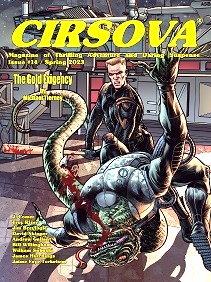“The Unshrouded Stars” by David Skinner
“Hunger in the Void” by Andrew Gallant
“The Gold Exigency” by Michael Tierney (serial, not reviewed)
“Quicksilver” by J. Comer
“Comes the Hunter” by Bill Willingham
“Starring Hedy Lamarr” by Troy Riser
“The Feast of the Fedai” by Jim Breyfogle
“Egg” by Jaime Faye Torkelson
“Search Pattern” by William Suboski
Reviewed by Victoria Silverwolf
This issue offers more science fiction than usual, while not neglecting to provide tales of fantasy as well. The lead story combines both of these genres into a unique work of the imagination.
In “The Unshrouded Stars” by David Skinner, an astronaut is able to perceive supernatural beings. He makes a deal with a lamia. If she will refrain from devouring children for a year, he will take her with him on his next trip into space. She has a strange effect on the other astronauts. Complicating matters is the presence of magical creatures of a different kind.
The author manages to make an extraordinary premise believable. The lamia is an interesting character, both in physical description and in personality. The addition of another kind of being to the plot may be asking the reader to accept a little too much for full plausibility.
The protagonists of “Hunger in the Void” by Andrew Gallant are a space explorer and a robot. They journey through a star gate to investigate what lies beyond it. The discovery of a black hole and enemy aliens in need of rescue leads to a battle for survival.
The author’s style is reminiscent of old-fashioned pulp science fiction adventures, with phrases such as “trusty robotic companion” and “intrepid explorers” popping up frequently. The plot creates a reasonable amount of suspense, but has the black hole behaving in a bizarre way that strains credibility.
In “Quicksilver” by J. Comer, the outbreak of a deadly viral disease in a colony on the Jovian moon Callisto threatens to wipe out the inhabitants. Only the use of an extremely dangerous experimental rocket fuel allows help to arrive in time from the sister moon Io.
In the tradition of hard science fiction, the plot relies on facts about a particular chemical substance. The risk to which the protagonists expose themselves creates a great deal of tension. The premise requires the discovery of a rich source of mercury on Io, which may seem contrived.
“Comes the Hunter” by Bill Willingham combines apocalyptic fantasy with the feeling of a Western. The narrator tracks down the last of a group of sorcerers who have devastated the planet. Their battle involves swordplay and the use of an unexpected weapon.
The story has the gritty mood of grimdark fantasy, with a villain of pure evil and a hero who is hardly less bloodthirsty. The trick the hero uses against the villain is clever, logical, and surprising. One might wish for a more nuanced antagonist, rather than one bent on universal destruction.
“Starring Hedy Lamarr” by Troy Riser takes place in the late 1960s. A secret organization battles a mysterious enemy, based on the Moon, who is able to take mental control of certain people, resulting in zombie-like attacks. Two secret agents journey from London to New York to Florida in a blood-soaked odyssey to meet with the leader of the organization.
This is a wild ride indeed, moving at a frenzied pace with a plot that combines spy fiction, pulp science fiction, and horror. It is obvious that unnamed characters involved in the organization are fictionalized versions of Stanley Kubrick, Andy Warhol, and, of course, the movie star mentioned in the title. This adds a touch of campiness to a gruesome and violent story.
“The Feast of the Fedai” by Jim Breyfogle is one of several stories about a pair of adventurers in a typical fantasy world. In this tale, the male member of the duo has to hire mercenaries for his partner, who is out to restore herself as rightful ruler of her homeland. His task is blocked by a wealthy adversary who has already purchased all the available fighters, as well as an attempt at poisoning.
More so than with other stories in the series, full appreciation of this one requires familiarity with previous adventures. The plot involves the heroes possessing a certain magical item, which seems too convenient.
In “Egg” by Jaime Faye Torkelson, a group of scientists on a moon in a distant star system have to evacuate when threatened by a series of increasingly violent quakes. The final apocalypse leads to a startling discovery.
The main appeal of this story is the manner in which the author portrays a team of skilled professionals dealing with a crisis. The simple plot depends entirely on the revelation at the end, which many readers will find hard to accept.
As a child, the narrator of “Search Pattern” by William Suboski witnessed a woman cure his father of terminal cancer by touching him. As an adult, he uses his skill with computerized correlation of data to start a powerful, benevolent company that reduces worldwide disease and poverty. Secretly, he also searches for people like the one who healed his father. His quest leads to an encounter with the woman, in which he learns more about her special power.
Unlike other stories in the magazine, this is a quiet, sentimental tale. Some readers may find the climax undramatic, but others will appreciate its emotional appeal.
Victoria Silverwolf has to get the air conditioning fixed in both cars.
 Cirsova
Cirsova